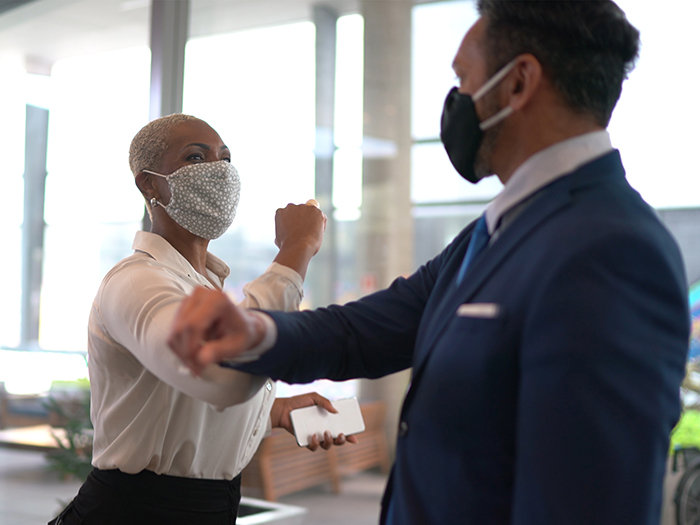2022’s Million Dollar Question: What Will the Workplace Look Like Coming Out of COVID?

If one thing is certain, it’s that our world has changed irreparably over the last two years.
The COVID-19 pandemic touched our lives in nearly every way. It changed how we live, how we work, how we hang out with friends and visit family. And many of those changes are poised to last well beyond the pandemic.
Just think about one simple scenario: going into the office with a slight cough. Before, it was common practice. After COVID-19, it’s almost unthinkable.
“If there’s something that can be positive out of this whole situation, it is the idea that you don’t have to be a hero. If you’re sick, stay home,” Dr. Craig Ross, regional medical director with Liberty Mutual, commented on the phenomenon.
During WCRI’s Annual Issues & Research Conference, the panel The Future of the Workplace after COVID-19 examined how our working lives can expect to change as we adapt to all of the disruptions brought on by pandemic life.
Ross was joined by panelists Denise Algire, director of risk initiatives and national medical director at Albertsons Companies; Dan Allen, executive director of the Construction Industry Service Corporation (CISCO); and Dr. Sebastian Negrusa, vice president of research, WCRI, for a discussion identifing a number of factors that will change how we work.
Here are four highlights from the session:
1) Vaccine Requirements
It’s been over a year since the first people received the COVID-19 vaccines. Ever since then, employers have been mulling whether or not to mandate vaccination for their workforce.
Without a federal mandate, employers may be wary of implementing their own vaccine mandates. Though it is well within a company’s rights to mandate vaccination, some may be worried about lawsuits and increased employment practices liability risk.
Algire explained during the WCRI panel how, in the wake of the Supreme Court decision, employers can lean on educational initiatives to help encourage hesitant employees to receive the vaccine.
“What’s happened over the last few months has made a tremendous impact and change on the way employers are likely approaching the main vaccine mandate,” Algire said.
“My personal approach has always been through education and empowerment.”
2) Long-COVID
In addition to considerations over vaccine requirements and preventing the spread of COVID-19 in the workplace, employers will need to be prepared to support workers who may contract long-COVID, a lingering condition that affects 10-30% of people who contract the coronavirus.
“The ADA is considering long-COVID a disability, so employers must understand and be ready to work with employees that may be struggling,” Algire said.
Long-COVID manifests in a variety of symptoms, including fatigue, brain fog, memory issues and loss of taste or smell, among other conditions.
“I was reading an article yesterday that identified 200 different symptoms in 20 different body systems,” Allen said.
As employers prepare to live with the virus, understanding how they can best support workers who contract long-COVID will be key.
“It’s not as straightforward as your typical workers’ comp claim,” Algire said.
3) Return to the Office?
The panel touched on a question that is on many workers’ minds: What will returning to the office look like now that case counts are dwindling after the Omicron wave?
Panelists highlighted the trend toward hybridity many white-collar employers are taking. Some are only requiring workers to come into the office twice a week or have implemented other more flexible arrangements.
Panelists agreed that flexibility is key, and surveying your workforce about their preferences and comfort-levels can give employers key insights in how to best implement return to office protocols.
“The transition plan that we have in place is to listen, understand where employees are, and we have a gambit of things from employees who can’t wait to get back to work to those that are quite comfortable working from home,” Algire said.
“So I don’t think it’s a one-size-fits-all. It has to be kind of a hybrid approach.”
And there are lessons to be learned from our essential workers, those employees who have been reporting to work in-person throughout the pandemic. Employers that are considering return-to-office plans should take note of some of the safety measures, like increased sanitation, better ventilation and masking and social distancing, which has kept many essential workers safe over the years.
“In the construction industry, work from home is not an option,” Allen said. “Employees got together at handwashing stations. [There had] scattered start times … so that we minimized the risks.”
4) The Great Resignation
The Great Resignation has been top-of-mind for many recently, with nearly every industry seeing workers exit as the pandemic shifted priorities.
The issue may feel all too familiar to many in the workers’ compensation and insurance spaces. Even before the pandemic, the industry was preparing for an impending talent shortage. The insurance industry was anticipating needing to fill 400,000 positions in 2020 even before the pandemic hit, Rising Medical reported.
“We already had a labor shortage problem. This is just exacerbating the issue,” Algire said.
With labor shortages come greater risks of injuries as employees work longer hours to fill the gaps. The workers’ compensation industry will need to anticipate those claims, and hopefully employers will try to prevent them by increasing safety procedures.
“The people who are working are working longer hours, which is more likely to lead to injury,” Algire said. &










